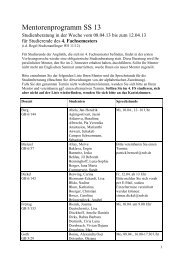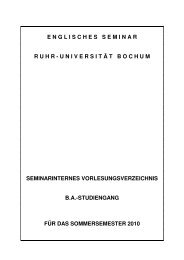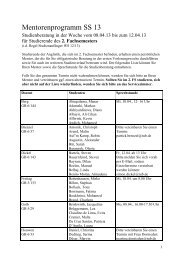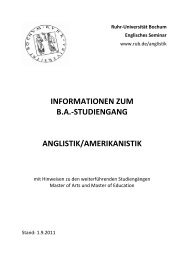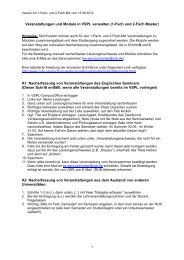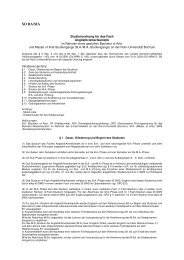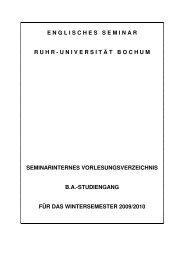Model Paper - Englisches Seminar - Ruhr-Universität Bochum
Model Paper - Englisches Seminar - Ruhr-Universität Bochum
Model Paper - Englisches Seminar - Ruhr-Universität Bochum
You also want an ePaper? Increase the reach of your titles
YUMPU automatically turns print PDFs into web optimized ePapers that Google loves.
Titles of independent<br />
publications, i.e. of books<br />
or journals, should be<br />
italicized. (Exceptions:<br />
the Koran, the Bible).<br />
A source must be acknowledged<br />
not only if it<br />
is quoted from directly but<br />
also if it is paraphrased.<br />
The use of a source must<br />
be documented immediately.<br />
Listing it in the<br />
bibliography or referring<br />
to it somewhere else in the<br />
paper is not enough.<br />
Since the bibliography<br />
contains a complete list of<br />
cited works, the author's<br />
name and the page numbers<br />
generally suffice to<br />
document a source in the<br />
main text of the paper (if<br />
possible, sources should<br />
not be indicated by footnotes).<br />
Footnotes are numbered<br />
consecutively throughout<br />
a paper. The existence of a<br />
footnote is indicated in the<br />
main text by a superscript<br />
Arabic numeral. The numerals<br />
should be placed<br />
immediately after the<br />
phrases containing the<br />
quoted material; they<br />
should follow, rather than<br />
precede, punctuation<br />
marks.<br />
Footnotes can be used<br />
for additional evidence<br />
which is relevant at a<br />
particular point in the<br />
paper but whose inclusion<br />
in the main text would<br />
interrupt the flow of the<br />
argument considerably.<br />
1. Introduction<br />
- 3 -<br />
Thomas Hardy's novels are all set in ''Wessex,'' a quasi-mythical region in<br />
southern and south-west England. The native community of this area was of<br />
particular interest to Hardy, and in The Return of the Native this community<br />
plays a greater role than it does in other works by Hardy.<br />
This paper will analyse the function of the rustics on the levels of setting,<br />
character, point of view, plot, and theme. It will be shown that, in The Return<br />
of the Native, the significance of the rustic characters is not limited to providing<br />
mere background scenery or local colour; instead, these characters fulfil<br />
various important functions such as commenting upon the main characters,<br />
offering an alternative to the intellectualised world of the main characters, and<br />
providing a form of comic relief.<br />
2. The Place of the Minor Characters in the Structure of the Novel<br />
2.1. Setting<br />
The Return of the Native is set on Egdon Heath, a vast area in Hardy's fictitious<br />
Wessex. All the twists and turns of the plot occur on the heath, which<br />
takes on the form of a closed microcosm of human existence. While some critics<br />
have claimed that the heath itself may be regarded as the major character<br />
(Fricker 228), the role of the heath people must not be neglected. The rustics<br />
set the stage on which the main characters enact their tragedy; and yet they are<br />
more than "bush[es] on legs." 1<br />
The natives' relationship to the heath has been a subject of Hardy scholarship<br />
for some time. While formerly critics claimed that the heath people live in<br />
harmony with nature (Holloway 48), more recent criticsm has come to<br />
acknowledge that this relationship is not very harmonious. Von Ziegesar, for<br />
instance, argues that the heath is ''doomed to decay'' from the very beginning<br />
of the novel (52).<br />
Indeed, there are several hints in The Return of the Native that the rustics'<br />
relationship to the heath is at best ambiguous. At the very beginning, after the<br />
lighting of the bonfires, the natives are set against the primeval natural powers<br />
of the heath, which are described as destructive:<br />
1 Hardy himself chooses this image: "Every individual was so involved in furze by his<br />
method of carrying the faggots that he appeared like a bush on legs till he had thrown<br />
them down" (65, emphasis added).




